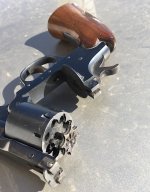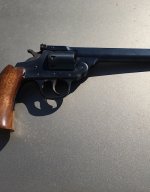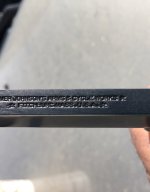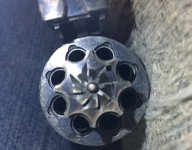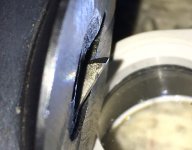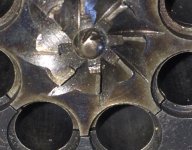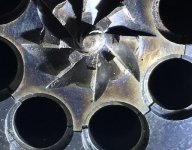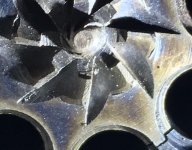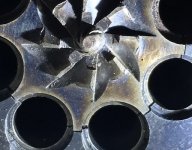I need an understanding of how the Iver Johnson is timed. I have a very nice example from the 50’s that is in incredible condition but appears to be out of time and produces 6-8” patterns instead of groups from a rest at 25 yards. I really like the gun and would like it to shoot better.
After sighting it in and having terrible ‘patterns’ I noticed that the cylinder would not always make it to full lock up. In single action I could manually turn the cylinder a fraction after the hammer was pulled back. When it did this, and it only happens some of the time, the cylinder would have stopped short of reaching lock up. The trigger is such that it can be staged easily in double action. While staging it appears to always reach full lock up. Also, if the single action is worked ‘smartly’ it tends to reach full lock up. But of course the cylinder is moving faster when doing so. I decided a good cleaning was in order to see if hardened grime was limiting travel in the action. Upon inspection I found the barrel significantly ‘leaded’ specifically on one side including the forcing cone. I suspect this was due to repeated firing with the firearm out of time. Lead was removed and all external parts were soaked and cleaned. I did not remove the internals on this solid frame revolver. I have had problems with solid frame revolvers before. I have since reviewed several videos and am confident I can disassemble and reassemble this revolver. It really only needs 2 slave pins and the assembly isn’t that complicated.
Although there may be grime inside I am not expecting parts wear on the internal parts based on the overall condition of the revolver. Could be wrong but I’m not sure I will be able to tell the if any of the parts are worn. It’s not like there are fabrication drawings available that I can compare to the parts.
So after removing the lead and the external cleaning, I did spray solvent inside the solid frame and flush it out/lubricate, the timing did improve but the single action still needed to be operated ‘smartly’ to consistently bring the cylinder to lock up. Better but not cured. Anxious to see how well it grouped with a clean/unleaded barrel/forcing cone I tested it yesterday making sure all shots were taken with the cylinder in the lock up position before firing. I was able to get a couple of 2” groups at 25 yards rested. Most of the 8 shot groups still had2 or 3 flyers opening the group to 6-8”. I couldfrom time to time feel lead spitting on my face. The right side of the frame, looking from the rear, did have external lead showing while the left side did not. The cylinder rotates from left to right viewed from the rear. I note that the Pawl/hand moves up slightly when the trigger is pulled but the cylinder does not rotate any further.
To begin with I’d like to learn what the designed lock up condition is and I’m hoping some of the professional gunsmiths remember. Does the “pawl”, I always called it a hand, just move the cylinder to the cylinder stop position and the let go? Or should the pawl/hand remain in contact driving the cylinder to farthest part of the cylinder stop notches. When in what I believe is the lock up position the cylinder has a slight amount of back and forth play. Not unlike any S&W revolver. The cylinder stop appears to be fully in the cylinder stop notches. I base this statement on the fact that the cylinder can move only slightly back and forth about the amount the notches would allow based on their size. I can’t see that so I’m willing to accept that observation as incorrect. Or any of my observations for that matter.
I really like the gun. If you knew me you’d agree this revolver just calls my name. But not if it can’t shoot well. The action parts that are responsible for timing appear to be unchanged from the original design of not only the Supershot/Sealed 8 models but also the 32 and 38 S&W models.
I plan to disassemble the internals and clean but I suspect it will not change the issue. Any help even understanding what the lock up condition is would be helpful. Any suggestions on what the issue/cure would be is also appreciated. I can post photos. Just let me know what you want/need.
After sighting it in and having terrible ‘patterns’ I noticed that the cylinder would not always make it to full lock up. In single action I could manually turn the cylinder a fraction after the hammer was pulled back. When it did this, and it only happens some of the time, the cylinder would have stopped short of reaching lock up. The trigger is such that it can be staged easily in double action. While staging it appears to always reach full lock up. Also, if the single action is worked ‘smartly’ it tends to reach full lock up. But of course the cylinder is moving faster when doing so. I decided a good cleaning was in order to see if hardened grime was limiting travel in the action. Upon inspection I found the barrel significantly ‘leaded’ specifically on one side including the forcing cone. I suspect this was due to repeated firing with the firearm out of time. Lead was removed and all external parts were soaked and cleaned. I did not remove the internals on this solid frame revolver. I have had problems with solid frame revolvers before. I have since reviewed several videos and am confident I can disassemble and reassemble this revolver. It really only needs 2 slave pins and the assembly isn’t that complicated.
Although there may be grime inside I am not expecting parts wear on the internal parts based on the overall condition of the revolver. Could be wrong but I’m not sure I will be able to tell the if any of the parts are worn. It’s not like there are fabrication drawings available that I can compare to the parts.
So after removing the lead and the external cleaning, I did spray solvent inside the solid frame and flush it out/lubricate, the timing did improve but the single action still needed to be operated ‘smartly’ to consistently bring the cylinder to lock up. Better but not cured. Anxious to see how well it grouped with a clean/unleaded barrel/forcing cone I tested it yesterday making sure all shots were taken with the cylinder in the lock up position before firing. I was able to get a couple of 2” groups at 25 yards rested. Most of the 8 shot groups still had2 or 3 flyers opening the group to 6-8”. I couldfrom time to time feel lead spitting on my face. The right side of the frame, looking from the rear, did have external lead showing while the left side did not. The cylinder rotates from left to right viewed from the rear. I note that the Pawl/hand moves up slightly when the trigger is pulled but the cylinder does not rotate any further.
To begin with I’d like to learn what the designed lock up condition is and I’m hoping some of the professional gunsmiths remember. Does the “pawl”, I always called it a hand, just move the cylinder to the cylinder stop position and the let go? Or should the pawl/hand remain in contact driving the cylinder to farthest part of the cylinder stop notches. When in what I believe is the lock up position the cylinder has a slight amount of back and forth play. Not unlike any S&W revolver. The cylinder stop appears to be fully in the cylinder stop notches. I base this statement on the fact that the cylinder can move only slightly back and forth about the amount the notches would allow based on their size. I can’t see that so I’m willing to accept that observation as incorrect. Or any of my observations for that matter.
I really like the gun. If you knew me you’d agree this revolver just calls my name. But not if it can’t shoot well. The action parts that are responsible for timing appear to be unchanged from the original design of not only the Supershot/Sealed 8 models but also the 32 and 38 S&W models.
I plan to disassemble the internals and clean but I suspect it will not change the issue. Any help even understanding what the lock up condition is would be helpful. Any suggestions on what the issue/cure would be is also appreciated. I can post photos. Just let me know what you want/need.

